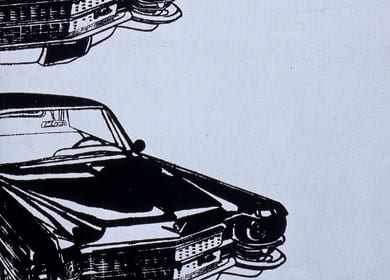 We have something in common with Andy Warhol (1928-87). I know it’s hard to believe. Yes, he’s the one who claimed that, in the future, everyone would be famous for fifteen minutes. Yes, many believe that he is to blame for the debasement of our culture. Yes, he’s the one whose strange appearance was outdone only by his even stranger behavior.
We have something in common with Andy Warhol (1928-87). I know it’s hard to believe. Yes, he’s the one who claimed that, in the future, everyone would be famous for fifteen minutes. Yes, many believe that he is to blame for the debasement of our culture. Yes, he’s the one whose strange appearance was outdone only by his even stranger behavior.
The Museum of Art in Fort Lauderdale, Florida, however, presents an exhibition that reveals a more accessible Warhol, one with which we can identify, who reminds us of something we too easily forget. Organized by the Montclair Museum in New Jersey and drawn from the Andy Warhol Museum in Pittsburgh, Warhol and Cars: American Icons consists of forty-six works that explore Warhol’s life-long passion for cars, a passion shared by South Florida today.
In the fifties and sixties, the automobile became the quintessential American icon. It was the symbol of American style and ingenuity, an icon of freedom, mobility, individuality and sexuality; cruising, the road trip, drive-in movies, drag races, playing chicken and “lookout point.”
As a commercial designer, Andy Warhol was fascinated by the automobile’s elegant design and the desire that it embodied for an American public. The American Icons exhibition includes many works that reveal Warhol’s artistic celebration of the sheer grace and beauty of the automobile. But there was another aspect of the automobile that terrified Warhol – its connection to death. He called cars “death machines.”
Warhol left his career as a commercial designer to become a fine artist primarily because of his desire to deal with death creatively. Warhol was obsessed with death. Commercial design, which stokes our feverish desires to consume, is predicated on the denial of our death and all its accoutrements, like aging. Although Warhol was insatiably drawn to the rich, famous and powerful, it was always with an eye to their ephemeral and transitory nature—here today, gone tomorrow. This, too, is something we in South Florida –with our large retirement population on the one hand and our beach and club scene on the other, share with Warhol.
Death overshadows all of Warhol’s work. Warhol barely survived a brutal murder attempt in 1968 and suffered gunshot wounds to the chest. He bore the horrific scars on his body as a reminder of the nearness of death.
As Hollywood and Madison Avenue were busy glamorizing the automobile in the early sixties, Warhol was combing through private police files of fatal car accidents as research for the most powerful and revealing body of work of his career, the Death and Disaster Series (1963-64). Warhol created silkscreen prints from the photographs and applied them to canvas, often multiplying the image on the surface.
The American Icons exhibit includes two of these works. These images reveal the contradiction not only of the automobile, but also of life itself: such beauty, such ingenuity, such freedom and joy—and yet such ugliness, pain and horror. Installed in the middle of the exhibition, and tucked within a quiet, intimate space, these pictures alter the entire exhibition. It is impossible not to think of these images alongside every other work in the showcase.
MOA|FL also offers a modest but excellent survey of works by Warhol and his contemporaries, drawn from its permanent collection, entitled Pop Art in America, which puts Warhol and Cars into a broader dialogue with other artists fascinated by popular and consumer culture.
If we are honest with ourselves, Warhol’s struggle with his mortality and obsession with death – which he revealed through his artwork – is ours as well. It is all too easy to enlist our Christian faith in our refusal to acknowledge death, protecting our autonomy in direct contradiction to the gospel. We can make it, we can do it, just work harder, get in better shape, make more money, have more fun, and we can somehow insulate ourselves from death’s lurking presence.
But God’s grace does not improve us or complete our efforts. It re-creates us who are already dead. With the sun, the beaches, and the perpetually young and beautiful people here in south Florida, it is easy to forget that it is only by dying that we live (2 Corinthians 6:9). To embrace our mortality, to lean into our weakness, frailty, and death is not macabre. It opens us up to receive grace.
Perhaps we’re not that much different from Andy Warhol after all.
Join me each month as we explore the remarkable world of art and culture that reveals God busy at work in this world, through his radical, disruptive grace, if only we have eyes to see and ears to hear.
Warhol and Cars: American Icons is on view through February 10, 2013.
Daniel A. Siedell a faculty member at Knox Theological Seminary in Fort Lauderdale, Florida and curator of LIBERATE, the resource ministry of Tullian Tchividjian and Coral Ridge Presbyterian Church. Before coming to South Florida he spent fifteen years as an art museum curator and art history professor.

Comments